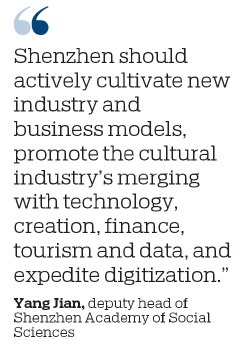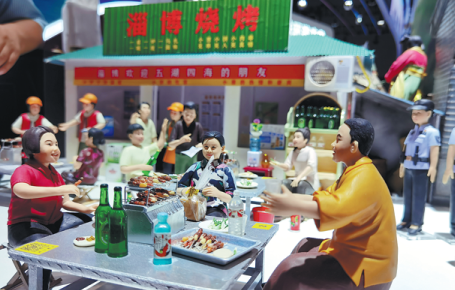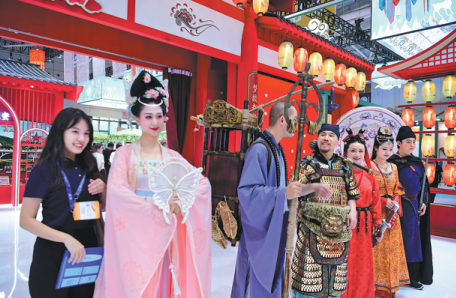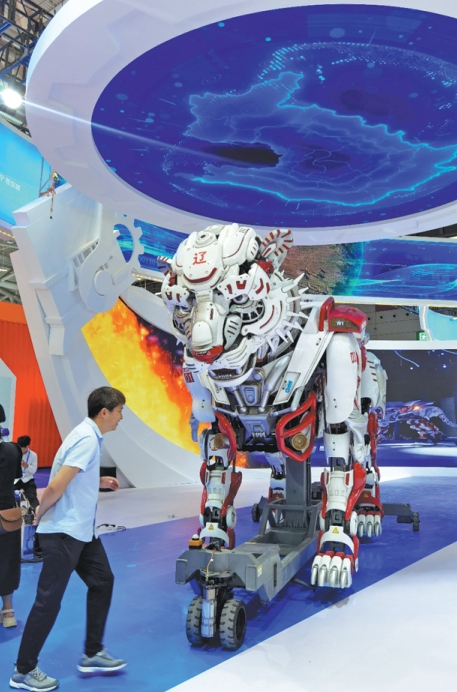Shenzhen fair spotlights cultural industry and hi-tech applications
The 19th China (Shenzhen) International Cultural Industries Fair, running Wednesday to Sunday, provides a platform for domestic cultural industry companies to interact with their foreign counterparts on exchanges, investment and project cooperation while highlighting the industry's merging trend in technological applications.
With its main venue at the Shenzhen World Exhibition & Convention Center in Bao'an of Shenzhen, Guangdong province, about 3,596 exhibitors are taking part in the fair, including more than 300 from 50 foreign countries and regions. The fair also includes 64 branch venues in all districts of the city and two virtual platforms — its official website and "wenbohui+", a software application on WeChat.
The six major exhibition halls at the main venue, encompassing a total of 120,000 square meters, are devoted to digital technology, cultural industries, the Guangdong-Hong Kong-Macao Greater Bay Area, cultural consumption, the Belt and Road Initiative and intangible cultural heritage, including arts, crafts and design.
The online element of the fair uses panoramic shooting technology to display cultural products and projects on the cloud platform synchronously and sets convenient stages for exchanges among cultural enterprises, customers and investors.
On the sidelines, exhibitors are engaging in supporting activities such as conferences, symposiums, forums, contract signing ceremonies and creative competitions, as well as releasing new policies, reports and regulations.
According to Zeng Xianglai, chief of the Shenzhen bureau of culture and tourism, this year's fair is focused more on brokering concrete transactions and cooperation through promotion of investment, unveiling new products and technologies, and boosting cultural consumption — especially via e-commerce platforms.
Zeng said the fair adheres to the national culture digitization strategy and the strategy of leading major cultural industry projects, and the debut of the Digital China exhibition area highlights national cultural industry market players, major platforms and the latest technological breakthroughs. As well, the exhibition has increased its number of participating cultural enterprises related to the application of new technologies such as 5G, big data, cloud computing and artificial intelligence, demonstrating the industry's diverse potential.
According to Liu Wenbin, deputy director of the publicity department of the Shenzhen Committee of the Communist Party of China, the fair actively promotes international cultural exchanges and trade by including special exhibition areas for Europe, Asia, the Middle East, Africa, Latin America and other regions, as well as import trade exhibitions aimed at expanding and strengthening cultural trade by focusing on supply and demand.
Since the first fair was held in Shenzhen in 2004, when about 700 exhibitors from a handful of countries and regions took part, the annual event has showcased achievements in the development of the cultural industry and promoted innovation at the national level while driving rapid development of the cultural industry in the city.
The added value of Shenzhen's cultural industry in 2022 is expected to reach 260 billion yuan ($36.57 billion), accounting for 8 percent of the city's GDP, an increase from 81.4 billion yuan in 2013, when it accounted for 5.3 percent of the city's GDP. The number of cultural enterprises in Shenzhen now exceeds 100,000, creating more than 1 million jobs.
Enterprises related to the cultural industry in Shenzhen have been the most direct beneficiaries of the annual event over the past 19 years. The city's creative design, animation and e-games, digital culture and other industries have drawn tangible benefits from the fair, and a number of nationally renowned cultural enterprises have emerged in the city. Shenzhen currently has 71 cultural industrial parks at or above the municipal level, with a total operating revenue of more than 150 billion yuan ($21.5 billion).
In a recent interview with local media, Yang Jian, deputy head of Shenzhen Academy of Social Sciences, urged the city to take advantage of the fair to improve its competitiveness in the cultural industry and accelerate its high-quality development.
Yang said: "Shenzhen should actively cultivate new industry and business models, promote the cultural industry's merging with technology, creation, finance, tourism and data, and expedite digitization."
In particular, Yang believes Shenzhen should continue to promote the development of creative design, expand the modern fashion industry cluster and integrate high-end creative design resources at home and abroad to enhance the city's capacity to accommodate creative design innovation.
Yang also suggested Shenzhen should pay special attention to strengthening the internationalization of its cultural industry by encouraging more cultural enterprises to expand their international profile by taking part in global competitions and utilizing global resources.


A set of soft clay work shows how to eat Zibo barbecue at the 19th China (Shenzhen) International Cultural Industries Fair. CHEN HONG/CHINA DAILY

A group of performers pose for photos at the fair. WEN ZI/FOR CHINA DAILY

A futuristic tiger shaped biomimetic robot is exhibited at the fair. CHEN HONG/CHINA DAILY










